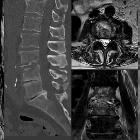Osteochondrosis intervertebralis
Intervertebral osteochondrosis represents the pathologic degenerative process involving the intervertebral disc and the respective vertebral body endplates (not necessarily symptomatic). It is believed to be different and a further stage of spondylosis deformans, which is a consequence of normal aging.
Terminology
It should not be confused with the general use of "osteochondrosis", which is a generic term given to a group of disorders that affect the progress of bone growth by bone necrosis.
Radiographic features
It is characterized by disc space narrowing, severe disc fissuring, vacuum phenomenon, endplate cartilage erosions, and vertebral body reactive changes (osteophytes and Modic changes).
Siehe auch:
und weiter:
 Assoziationen und Differentialdiagnosen zu Osteochondrosis intervertebralis:
Assoziationen und Differentialdiagnosen zu Osteochondrosis intervertebralis:





